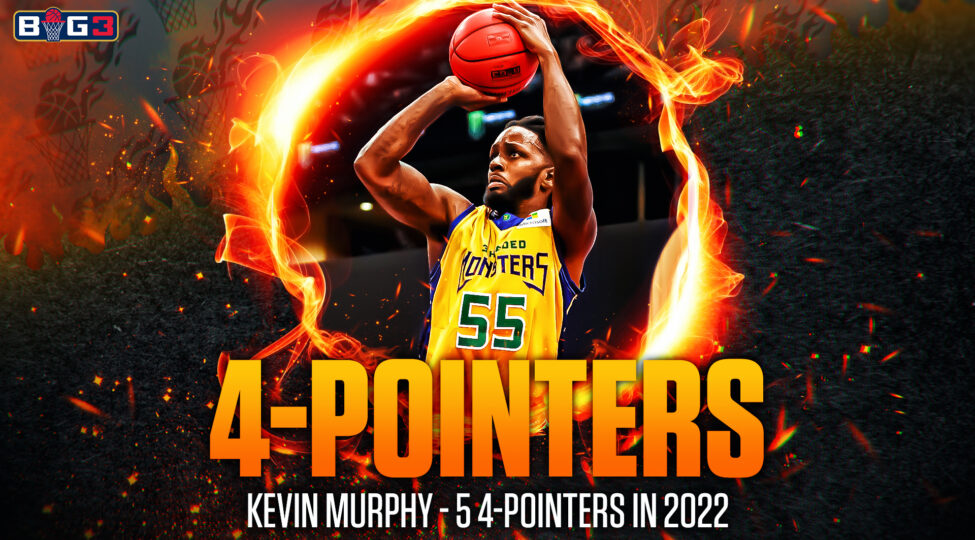The four-point shot is one of the signature elements of the BIG3; no other basketball league incorporates a four-point shot in each one of its games. and one of the most exciting plays in any BIG3 game is watching the ball fly through the air after a player launches a ball from deep, hoping to get the game-changing reward of putting a full four points on the board for his team.
A question that still surrounds the four-point shot is just how it should be used. Is it a gimmick shot that should only be used when a player is absolutely feeling it or a team is desperate? Or should it be a part of every team’s strategy? There are a lot of factors that go into answering that question, some of which we’ll address later, but for now let’s just look at the numbers.
Here’s a brief detour into the role looking at the numbers, or “analytics,” played in the NBA’s “three-point revolution.” When people started charting how often NBA players made mid-range jump shots, they found out that virtually no player made at least 50% of their jump shots from two-point range. Simple math tells us that a 33% three-point shooter is as efficient as a 50% two-point shooter and a 40% three-point shooter is as efficient as a 60% two-point shooter. That means that a decent three-point shooter is as efficient as a great two-point jump shooter, and a very good three-point shooter blows any two-point jump shooter out of the water. For those reasons, among others, teams started taking way more three-point shots and way less two-point jump shots.
With that in mind, let’s look at the efficiency of the four-point shot. It’s easy to determine how efficient a four-point shot is in relation to a two-point shot; just double the four-point percentage to figure out how valuable it is in relation to a two-point shot.
So should players have been more aggressive from the four-point circles last season? Well, BIG3 players shot 102 shots from four-point range last season, and made 28 of them. That’s a 27.5% conversion rate, which is equivalent to a 55% conversion rate from two-point range. That’s pretty good! A few other notes:
– Kevin Murphy was the undisputed Lord of the Four last season. He made a league-leading five four-point shots and attempted 13. That’s a percentage of 38.5%, or a “true” percentage of 77%. He also won the inaugural BIG3 four-point contest.
– The only other player to make more than two shots from four-point range was Michael Beasley, who made four of the 11 four-point shots he took, good for a percentage of 36.3% and a “true” percentage of 72.6%.
– 11 players missed the only four-point shot they took over the course of the season. The player who took the most four-pointers without managing to make one was Gerald Green, who missed all four of his attempts. Given how good of a shooter Green is from everywhere else on the floor, I’d expect him to swish a few shots from all the way downtown next season.
So, should BIG3 players be taking more four-point shots? Just from the numbers, I’d say yes. 55% is pretty good efficiency, and the players who shoot the four-pointer the best are ludicrously efficient from that range. Furthermore, apart from a few brief flashes, we haven’t seen teams game-planning to get their players four-point looks, and guys are still mostly treating the shot as a gimmick rather than a weapon.
Now, there is one fairly massive caveat. From the numbers, we see that the four-point shot is quite efficient, but it’s only efficient on a long enough timeline. Over 102 shots, the four-point shot was as efficient as a 55% two-point shot. However, if your goal is just to score a basket, the four-point shot goes in 27.5% of the time. Furthermore, the shot is rare enough so that no player made over one four-pointer a game. It would be tough enough for a team or player to get up enough four-pointers for the “odds to even out” in an NBA game, where each team scores over 100 points a game, but in FIREBALL3, where the game ends when one team makes it to 50 points, it’s nearly impossible for the “true” percentage to come out.
Think about it like this: a pass that travels over 10 yards in the air might be a highly efficient part of a football team’s offense over the course of a game, but they’re almost certainly not going to throw one on fourth and one, when they just need to move the ball forward.
You can also think of it in terms of running a casino. The casino’s only “edge” at the roulette wheel are the 0 and 00 numbers, which you probably won’t see the ball hit once when you play. However, since multiple wheels get spun thousands of thousands of times each every single day, those two little numbers become all the casino needs to essentially guarantee themselves a profit.
FIREBALL3 players don’t have the luxury of acting like casinos and getting to wait for the “true” odds to kick in. For that reason, it’s not quite fair to say four-point shots are as efficient as they look on paper, especially in the FIREBALL3 format. That’s probably a good thing, because as fun as the occasional four-pointer is, an entire game of guys hurling up 30-footers and missing nearly three quarters of them wouldn’t be all that much fun to watch. Still, if players or teams want to be more aggressive mixing the four-pointer into their play, the numbers suggest it just might work.



